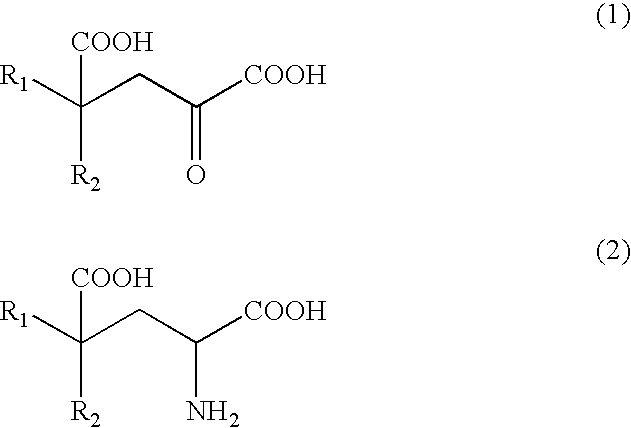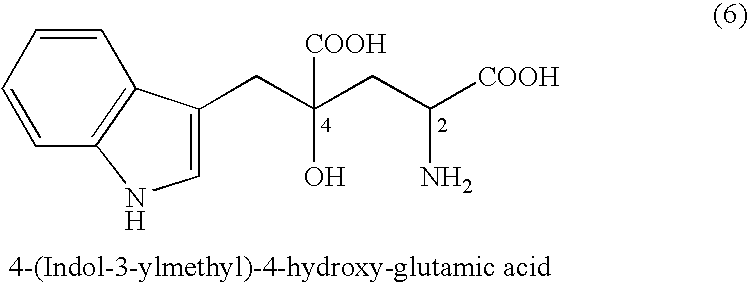Process for producing glutamate derivatives
- Summary
- Abstract
- Description
- Claims
- Application Information
AI Technical Summary
Benefits of technology
Problems solved by technology
Method used
Image
Examples
example 1
[0358] Example 1 relates to reaction 1 of the invention. In Example 1, L-tryptophan, indole-3-pyruvic acid and indoleacetic acid were measured by high performance liquid chromatography (column: liertsil ODS-2 (4.6×250 mm); column temperature: 40° C.; eluate: 0.1 M KH2PO4—H3PO4 (pH=2.80) / CH3CN=1 / 9 to 5 / 5; flow rate of 1.0 ml / min; detection: UV 210 rnm).
(1-1) Generation of Indole-3-pyruvic Acid from L-Trp Via the Reaction of Microbial Cells with Amino Acid Oxidase Activity
[0359] 50 ml of a culture medium, pH 7.0 containing 1 g / dl yeast extract, 1 g / dl polypeptone, 0.3 g / dl (NH4)2SO4, 0.3 g / dl K2HPO4, 0.1 g / dl KH2PO4, 0.05 g / dl MgSO4.7H2O, 1 mg / dl FeSO4.7H2O, and 1 mg / dl MnSO4.4H2O were placed in a 500-ml Sakaguchi flask for sterilization at 110° C. for 10 minutes.
[0360] One loop of Achromobacter sp. AJ2425, Proteus rettgeri IFO13501 or Morganella morganii IFO3168 preliminarily cultured in a bouillon agar culture medium at 30° C. for 24 hours was inoculated to the culture medium an...
example 2
[0369] In Example 2, the reaction 2 is performed using a chemical synthetic system.
(2-1) Synthesis of 4-(indol-3-ylmethyl)-4-hydroxy-2-oxoglutaric acid (IHOG)
[0370] 7.50 g of indole-3-pyruvic acid (35.8 mmol; content of 97.0% by weight) and 14.18 g of oxaloacetic acid (107.4 mmol) were added to and dissolved in 64.45 ml of water preliminarily dissolving 18.91 g of potassium hydroxide (286.5 mmol; content of 85% by weight) therein. The mixture solution was agitated at 35° C. for 24 hours.
[0371] Further, 40.0 ml of 3N hydrochloric acid was added for neutralization (pH 7.0), to obtain a neutralized reaction solution of 153.5 g. The neutralized reaction solution contained 5.55 g of IHOG, so the yield was 53.3% (vs. indole-3-pyruvic acid).
[0372] Water was added to the neutralized reaction solution to 168 ml and passed through a resin column (diameter of 4.8 cm) packed with 840 ml of a synthetic adsorbent (DIAION-SP207 manufactured by Mitsubishi Chemical Corporation). Further, pure w...
example 3
[0376] In example 3, reaction 2 is performed using an enzymatic system. In Example 3, herein, IHOG and PHOG used as substrates were synthetically prepared by the method described in Example 2.
(3-1) Screening of Microorganism with the Activity of Aldolase for PHOG (Referred to as PHOG Activity Hereinafter)
[0377] Screening of microbial strains having the aldolase activity was performed, wherein 4-phenylmethyl-4-hydroxy-2-oxoglutaric acid (PHOG) was used as a substrate.
[0378] Test microorganisms (bacteria and yeast) were inoculated on a bouillon plate culture medium (Eiken Chemical Co., Ltd.), for culturing at 30° C. for 24 hours. The resulting culture was inoculated on a plate containing 0.5 g / dl glycerol, 0.5 g / dl fumaric acid, 0.3 g / dl yeast extract, 0.2 g / dl peptone, 0.3 g / dl ammonium sulfate, 0.3 g / dl K2HPO4, 0.1 g / dl KH2PO4, 0.05 g / dl MgSO4.7H2O, 0.25 g / dl sodium phthalate, and 2 g / dl agar powder (pH 6.5), for culturing at 30° C. for 24 hours. The resulting microbial cells we...
PUM
| Property | Measurement | Unit |
|---|---|---|
| Mass | aaaaa | aaaaa |
| Mass | aaaaa | aaaaa |
| Mass | aaaaa | aaaaa |
Abstract
Description
Claims
Application Information
 Login to View More
Login to View More - Generate Ideas
- Intellectual Property
- Life Sciences
- Materials
- Tech Scout
- Unparalleled Data Quality
- Higher Quality Content
- 60% Fewer Hallucinations
Browse by: Latest US Patents, China's latest patents, Technical Efficacy Thesaurus, Application Domain, Technology Topic, Popular Technical Reports.
© 2025 PatSnap. All rights reserved.Legal|Privacy policy|Modern Slavery Act Transparency Statement|Sitemap|About US| Contact US: help@patsnap.com



